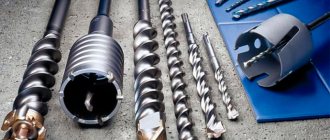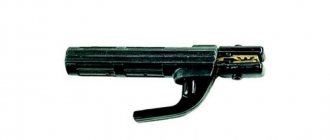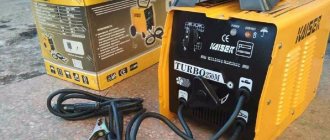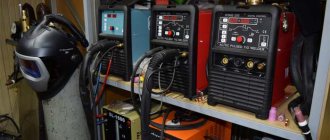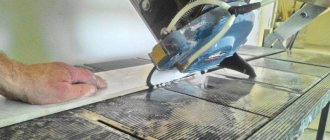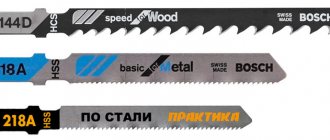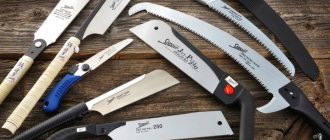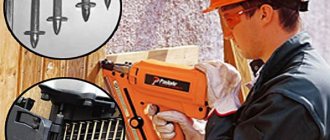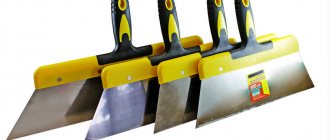Blower rating
The purpose of writing the rating is to provide a list of high-quality, reliable, productive tools with an optimal price-quality ratio. To do this, 150 customer reviews were studied, on the basis of which 3 dozen popular products were selected. We managed to weed out weak candidates after viewing expert reviews, consultations with sellers, as well as blower owners.
The main characteristics that were paid attention to during the selection were the following:
- Type - gasoline, electric or battery;
- Functions – blowing, suction or grinding;
- Volume, air flow speed;
- Power;
- Duration of operation without refueling or recharging;
- The presence of a garbage container, suction pipe or battery;
- Transportation method: using a handle or shoulder straps;
- Guarantee period;
- Weight, dimensions.
The results of the analysis and comparison of the parameters of all applicants is a TOP list with 10 winners. The remaining products were not included in the rating due to poor quality assembly, noisy operation, inconvenience to use, and overpriced. Many candidates had weak power and, as a result, low productivity.
Blower Applications
Despite the fact that vortex compressors do not have maximum efficiency (approximately 80%), these technological inventions can make the production process cheaper and easier, if, of course, we are talking about relatively low capacities. Moreover, an industrial blower can save 50% of electricity and pay for itself in no more than three years of operation. When thinking about which blower to use, for the efficient operation of industrial blowers, when choosing equipment, it is necessary to take into account the amount of air consumed at aeration stations and the pressure indicator, which is used to calculate the productivity level of blower systems.
In general, it must be recognized that blowers are widely used in various technological processes. This equipment is often used for water aeration and pneumatic transportation of bulk materials such as grains, flour, cement, milk powder and cream. Blowers are also used to support the combustion process in drying and roasting ovens. The majority of blowers (about 60%) are used in aeration devices in wastewater treatment plants. Blowers have found their application not only in industrial activities, but also, for example, in the film industry. This equipment helps dry films using low pressure air flow.
The film is developed, fixed, then removed from the tank, and only then the required amount of solution is removed by blowing with a low-pressure air stream. Then the film is dried using a vacuum. Blowers are widely used in production areas related to vacuum: in vacuum casting, in vacuum packaging processes, in taking gas samples using vacuum. And also when cleaning from pollution, in centralized dust removal systems, in the food industry. For example, air compressors are used in metallurgy. As you can see from all of the above, the range of applications is extremely wide.
Best Gasoline Leaf Blowers
Such models are characterized by high power and productivity, so they can easily cope with cleaning large areas. Due to their impressive weight, they are most often equipped with straps for carrying on the shoulders. The advantage of gas-powered tools is complete independence from wires and sockets, as well as long-term operation without refueling. A device with a tank volume of 0.5 l provides an hour of continuous operation. The disadvantages include harmful exhausts and high noise levels. 7 participants competed for the title of best in this category. The Vyborexperta.ru team carefully studied the parameters of each of them and, based on the best performance and ease of use, chose 3 winners.
Champion GBR357
The model is equipped with a two-stroke engine running on a fuel mixture of gasoline and oil in a ratio of 50 to 1. With a combustion chamber volume of 56.5 cubic meters. cm it produces good power - 3.4 liters. With. Thanks to this, the air speed reaches 99 m/s, and the air flow volume is 1080 cubic meters. m/hour. The high technical characteristics of the blower make it easy to clean hard-to-reach places: paths, slab joints. Also, the Champion GBR357 is indispensable when cleaning large areas from leaves, dust, debris, and branches.
During operation, there is no need to be distracted by refueling, since there is a spacious 1.8 liter fuel tank. Backpack suspension mechanism with soft straps evenly divides the load on 2 shoulders. Due to this, the operator’s back is not overstrained, and his hands practically do not get tired during prolonged use. The multifunctional handle allows you to easily operate the unit with one hand or move it to the desired location.
For efficient flow distribution, the plastic pipe has a flat shape. It is connected to a flexible hose and is adjustable in length, which greatly facilitates control. The body of the device is resistant to shocks and other mechanical damage, since a high-strength polymer was used for its manufacture. Convenient starting of a cold engine is possible thanks to the installed air damper.
Advantages:
- Flow speed is adjustable;
- Wide flat base allows placement on any surface;
- Translucent tank for monitoring fuel level;
- All controls are concentrated in one place, near the handle;
- Stylish design.
Flaws:
- Impressive weight – 9.2 kg.
Due to the anti-vibration system, all harmful vibrations from the engine are damped by dampers, which eliminates user discomfort during prolonged use.
Stihl BG 50
The tool has a fairly strong speed (514.8 km/h), a good volume of air flow (700 cubic meters/hour). Therefore, it is suitable for cleaning courtyards, garden areas, as well as playgrounds and small parks. Autonomy is provided by a 2-stroke engine with a gasoline tank capacity of 0.5 liters, which will be enough for an hour of operation without refueling. Due to its location in a vertical plane, it is easy to fill.
To reduce the number of starting jerks after a long break, a hand pump is provided. It allows you to pump fuel into the carburetor with just one finger press. An ergonomic handle with built-in controls is installed above the middle of the body, making all operations easy to perform with one hand. Soft inserts on the handle provide comfort and protect your hands from calluses.
The unit can be worn on either the left or right side. To clean the air filter, there is no need to call a specialist, as it is easy to do yourself. The STIHL BG 50 is equipped with an anti-vibration system, which eliminates discomfort from high vibrations during work. The throttle lever allows you to smoothly adjust the speed between idle and full throttle.
Advantages:
- Weighs only 3.6 kg;
- Can work in dry and wet weather;
- Affordable price;
- Good maneuverability;
- Economical.
Flaws:
- Not detected.
Makita BHX2501
Unlike previous leaders, the engine of this gasoline garden blower is made according to a 4-stroke design. Therefore, it does not require pre-mixing oil with gasoline. Device with a volume of 24.5 cubic meters. cm develops power up to 1.1 l. s, providing a decent flow (534 cubic meters / hour). The speed reaches 64.6 m/s, which makes it easy to deal with any waste over a long distance.
The spacious tank (0.52 l) makes it possible not to think about refueling during 1 hour of operation. For easy monitoring of fuel level, it is made of translucent plastic. Thanks to the implemented “Happy Start” soft start system, the vortex blower starts easily and quickly. The cover with a sliding mechanism provides instant access to the spark plugs.
Installing a special gas lever clamp solved the problem of maintaining flow stability. The ergonomic handle facilitates convenient transportation and handling. To prevent slipping on surfaces, the design includes special feet. In addition to the main function of blowing, the Makita BHX2501 performs grinding and suction.
Advantages:
- High build quality;
- Optimal weight – 4.6 kg;
- Cost-effective;
- Accelerates to 7800 rpm;
- Low vibration level.
Flaws:
- The shredding knife, garbage container, and suction pipe must be purchased separately.
Makita BHX2501 produces 50% less emissions of harmful substances into the environment compared to similar models.
What is an industrial blower
Industrial blowers have other more informative names that immediately give an idea of the scope of application. Professionals call them:
- Gas media (air) blowers;
- Gas blowers;
- Exhaust systems;
- Vortex fans;
- Vacuum pumps;
- Compressor.
However, vacuum pumps and compressors are slightly different equipment, and air blowers and exhaust systems for blowers are more correct names.
So, a blower is a piece of equipment that can force air into a system without creating high pressure in it. Or a blower can pull air out of the system, creating a shallow vacuum in the system.
The first classification of blowers is:
- Industrial;
- Household.
For example, an air blower used to blow away leaves on a property is a household appliance. They have low power, a discharge volume of up to 200-250 cubic meters, and low weight.
For industrial blowers, the maximum excess pressure can reach 1000 mbar, and the volume of pumped air up to 1500 cubic meters. meters.
This is a good time to differentiate between blowers, compressors and vacuum pumps. A compressor can only pump air at a much higher pressure than a blower. There is a similar difference between a vacuum pump and an exhaust system, only with a minus sign - the hoods do not create high vacuum.
Best Electric Leaf Blowers
Such tools are distinguished by their compact dimensions, light weight, and affordable cost. They are suitable for cleaning medium to small sized areas. Unlike gasoline counterparts, electric models operate quietly and do not emit harmful gases, so they can be used indoors. This category presents the 4 best models operating from a 220V network, selected based on positive customer reviews.
Greenworks GBV2800
The tool is equipped with a powerful brushed motor (2.8 kW), providing high performance of 840 cc. m/h. It has proven itself well in cleaning dry leaves, grass, dust and other debris from lawns, gardens, and home areas. The unit supports smooth adjustment of air flow speed. Based on the type of vegetation, you can choose 270 or 320 km/h.
Greenworks GBV2800 combines the functions of blowing, suction, and grinding. For this purpose, the model is equipped with a special retraction nozzle and a spacious 45-liter waste bin. The collected waste is crushed by steel knives built into the turbine housing. Subsequently, the resulting mass can be used as a compost material.
The turbine impeller is made of durable steel, so the device will last for many years. Special protection is provided against accidental entry of foreign objects into its blades. Based on reviews, the electric blower is easy to control and transport due to the built-in rubberized handle. Its power is maintained using a network or battery, which must be purchased separately along with the charger.
Advantages:
- Low price;
- Light weight – 4.2 kg;
- Warranty 2 years;
- Presence of a fuse against accidental activation;
- Excellent balancing.
Flaws:
- High noise level – 104 dB;
- Not very comfortable handle.
Worx WG505E
The multifunctional device is suitable for cleaning the garden, park area and surrounding area from fallen leaves and debris. It also works effectively indoors. Due to the optimal angle of inclination of the nozzle, even the most difficult to reach areas can be processed without difficulty. Worx WG505E performs 3 functions: blowing, suction, grinding, which are easily switched by turning one lever.
A special bag is provided for collecting waste. Its volume is as much as 45 liters, which eliminates the need for frequent cleaning. The model is equipped with an electric motor with a power of 3000 W. It provides good performance of 600cc. m/hour and high speed 93.06 m/s. A lock is installed to prevent the power cable from breaking.
Thanks to the light weight (4.1 kg), the shoulder strap on the garbage bin and the ergonomic handle, the product is quite easy to move. For convenient storage, the pipe can be removed. Additional convenience during operation is provided by the function of adjusting the reproduced flow. You can choose 128 or 335 km/h.
Advantages:
- Long warranty period – 3 years;
- Metal impeller;
- Affordable price;
- Grinding ratio – 16:1;
- Easy one-handed operation.
Flaws:
- It is somewhat noisy.
Carver BV 2800E
The unit operates in blowing, suction, and grinding modes. It has shown the greatest effectiveness in cleaning mown grass, fallen leaves and other plant waste in medium-sized areas. After processing, the mass enters a special fabric bag. It is quite spacious (40 l), supports easy unloading function and is equipped with a window to control the fullness. At the grinding stage, the contents are reduced by 3 times, so emptying will not be necessary for a long time.
For a capacity of 720 cubic meters. m/h and the flow speed is controlled by a powerful electric motor (2800 kW), powered by a 220V network. During operation, the air speed can be adjusted in the range from 162 to 270 km/h. Thanks to the built-in wheels, the device easily takes a stable position and moves comfortably. Correct load distribution due to the shoulder strap and optimal weight (3.5 kg) ensures comfortable use for a long time.
Advantages:
- Low cost;
- Excellent for blowing away wet leaves;
- Easy assembly;
- Simple controls;
- High efficiency.
Flaws:
- Not very good quality of materials.
Black+Decker Beblv260-QS
Combines the functions of a blower, garden vacuum cleaner, and shredder. The design provides 2 replaceable nozzles and a 40-liter bag, equipped with a convenient opening and closing system. A thin tube is used for blowing, and a large one is intended for sucking up waste. The impeller of the pipe is made of high-strength polymer, so it is not afraid of impacts from stones and branches.
The tool has found its application in housing and communal services enterprises, as well as in country houses, country houses, and private houses. It does an excellent job of cleaning hard and soft surfaces from dry, wet leaves, small branches and mown grass. A powerful electric motor (2.6 kW) provides decent airflow at 316.8 km/h, minimizing cleaning time in hard-to-reach places. High performance 702 cu.m. m/h allows you to quickly cover large areas.
Advantages:
- Excellent build;
- Price-quality ratio;
- Capacious waste bin 40 liters;
- Optimal weight – 4 kg;
- Reduce waste volume in a ratio of 12:1;
- Relatively quiet operation - 90 dB.
Flaws:
- Not detected
During first operation, users often encounter the fuse tripping, which prevents the unit from being turned on. This is due to incorrect connection of the tube to the power unit. Basically, the problem is solved immediately after turning the pipe all the way.
Purpose of the blower
A blower is essentially a low-pressure compressor, which, depending on its design and functionality, is capable of performing a wide range of work:
- Cleaning the garden area from dry dirt, litter, fallen leaves and even snow. In this case, you can perform both a complete cleaning of the garden and local blowing of debris from hard-to-reach places. The blower works well when cleaning the lawn, since the air flow does not damage the plants, but effectively blows through uneven terrain.
- Drying of machine structures and equipment.
- For repair and construction work of almost any nature, including laying and restoring the road surface. Here they use powerful models that can cope with dust, shavings, small branches, and debris that has individual large and relatively heavy fractions. An example is the pothole repair of a road, where before laying new asphalt, at the last stage of preparation, all debris is blown out of the hole, thereby increasing the adhesion of the new coating.
- Cleaning the surrounding area of a private house or cottage, sweeping paths, sidewalks, putting things in order in parks and squares.
In addition to the obvious tasks, some models of leaf blowers can be used to spray plants, collect debris in a special attached bag, similar to a vacuum cleaner, and even mulch the collected plant material.
NOTE:
This tool is an effective tool for cleaning computer equipment from dust, unlike classic compressors, which often bleed condensate through the nozzle.
Operating modes
Blowers, depending on the model, can have one or several operating modes, which expands their functionality:
- Blowing is the main mode of operation, through which the blower turns, in fact, into a kind of rake with a motor, through which you can blow debris off paths and clean hard-to-reach places.
- Suction - turns the tool into a vacuum cleaner that draws debris through the nozzle, collecting it in a connected bag.
- Shredding - an addition to the previous function, allows you not only to collect garbage, but also to reduce its amount through grinding. Actually, based on the collected leaves and grass, the unit creates mulch, which can be used as fertilizer.
If the latter function is present, the documentation for the tool indicates the mulching ratio, for example, 1:10, which literally means how many times the volume of collected waste is reduced after grinding. On average, the coefficient is 1:7 – 1:16.
Best Cordless Leaf Blowers
Such devices are powered by batteries and are not tied to an outlet, which eliminates the possibility of electric shock. Their mobility and the absence of a wire make it possible to easily clean small areas with ornamental bushes, trees and other obstacles. The downside is lower power compared to network analogues, as well as limited operating time on one charge (enough for 15-60 minutes). VyborExpert specialists analyzed the characteristics of 6 candidates. After comparing them, 3 leaders received the highest score.
Bort BSS-18-Li
The device runs on a lithium-ion battery with a capacity of 1.30 Ah with a voltage of 18 V. At 13500 rpm. it delivers a respectable flow rate of 180cc. m/h and air speed 57 m/sec. Smooth 3-stage speed control is supported through a mechanical lock. The operating time on a single charge is 15 minutes. This is quite enough to clear the local area from fallen leaves and dry grass. It will take 1 hour to replenish it.
Bort BSS-18-Li operates in 2 modes: blowing, suction. For the latter, a reusable garbage collection bag is provided. It is important to note that the suction nozzle is equipped with a mesh with small holes (about 2 mm). Therefore, as a vacuum cleaner, it is better to use a blower only for collecting sawdust or fine dust from various surfaces. Lightness (1.7 kg) and a comfortable handle make the device comfortable to use and transport.
Advantages:
- Low noise level – 80 dB;
- Simple controls;
- Charge indication;
- Fits comfortably in the hand;
- Low cost;
- 2 year warranty.
Flaws:
- The battery snaps tightly;
- Ineffective in vacuum cleaner mode.
The capacity of the model can be increased, as the kit includes a removable battery.
Bosch GBL 18V-120
The model is designed for cleaning metal shavings, sawdust, stone dust, as well as waste generated during work at repair and construction sites. Bosch GBL 18V-120 also copes well with light organic matter: branches, leaves, pine needles. To effectively perform these tasks, the device is equipped with 4 accessories: a standard nozzle, an extended tube, a nozzle for drilling holes, and a dust collection nozzle.
The device runs on a li-ion battery with a voltage of 18 V, developing up to 17,000 rpm. Thanks to this, the maximum air speed is 270 km/h and the flow volume is 120 cubic meters. m/hour. Depending on the work, the air flow speed can be adjusted using a switch, selecting the position for light or heavy materials.
During operation, the operator does not experience any difficulties, since the battery-powered device has compact dimensions (52.3x15.8x22 cm) and light weight (1.1 kg without battery). The rubberized ergonomic handle promotes comfortable control and prevents the possibility of hand slipping. Due to the removable tube, the unit is convenient to store and transport.
Advantages:
- Compatible with all Bosch Professional 18 V batteries;
- Excellent value for money and quality;
- Withstands falls from a height of 2 m;
- Optimal noise level – 82 dB;
- Full discharge protection.
Flaws:
- The battery and charger are not included in the delivery package.
RedVerg RD-B18V
The device is designed for blowing away grass, leaves and other waste in the garden, country house or local areas. A powerful electric motor powered by a lithium-ion battery allows you to create good airflow up to 215 km/h. The work process is facilitated by the adjustment function, which supports 2 speed modes. The first is economical, suitable for branches and dry sand. The second is relevant for working with heavy, wet waste.
The handle has a soft elastic lining, which allows you to comfortably work with the tool in any position, providing a secure grip and preventing slipping. All controls are built into it, so operations can be easily performed with one hand. The RedVerg RD-B18V model is equipped with an air duct with a locking button on the body. Its cylindrical shape contributes to greater efficiency. For the manufacture of the impeller, a polymer that is resistant to impacts and scratches was used.
Advantages:
- Low cost;
- Compact dimensions – 15x17x41 cm;
- Compatible with REDVERG 18B batteries;
- Quick start with one button;
- Light weight – 1.7 kg.
Flaws:
- Supplied without charger and battery.
Coupling or belt?
In some classifications, blowers are divided into belt and coupling blowers, depending on the type of transmission.
In clutch-type blowers, the rotational torque from the engine to the working chamber is carried out by means of an elastic coupling. This design gained wide popularity earlier, but now both manufacturers and consumers prefer the belt drive type.
Why did it happen? The fact is that the cost of producing a belt structure has become comparable to a coupling one, and such a blower has quite a lot of advantages: a low level of vibration, the possibility of long-term non-stop operation, as well as more favorable thermal and load operating conditions.
How to choose a blower
When purchasing gas-powered tools for the private sector, special attention should be paid to models with an anti-vibration system, minimal noise levels and emissions of harmful substances. Devices powered by mains power are often equipped with an insufficient cable length, so be sure to check this parameter before purchasing. When choosing a cordless leaf blower, it is best to buy a model that is compatible with multiple types of batteries.
Power type
Garden assistants are powered by a gasoline engine, mains electricity or battery.
To process large open areas (more than 5 acres), it is better to pay attention to a gasoline power source. The autonomous version will easily collect any type of garbage and will delight you with long-term operation without refueling.
Mains-powered models will do an excellent job of cleaning medium-sized areas up to 5 acres. They are easy to operate, make virtually no noise, and are cheaper than their gasoline counterparts.
Battery power supply is a profitable option for small areas of up to 3 acres and rooms. It is especially relevant for owners of dachas, built-up courtyards, vegetable gardens, and gardens with densely planted trees and plants.
Power
The speed and volume of air flow depends on this parameter. The optimal power for cleaning medium-sized areas (up to 5 acres) is 2-3 kW for electric, 1-2 liters. c – for gasoline devices.
Airflow speed
Speed is measured in kilometers per hour (km/h) or meters per second (m/s). This parameter depends on the type of garbage that needs to be cleaned:
- For leaves, grass, pine cones, small branches, up to 250 km/h (70 m/s) is sufficient;
- For wet foliage – 250-290 km/h (70-80 m/s);
- A flow of 290 km/h (81 m/s) can blow away stones the size of half a brick.
Functional
Gardening tools perform 3 main functions:
- Blowing;
- Suction;
- Grinding.
In the first case, the blower, using a strong air flow, moves debris in the direction specified by the operator. Mode 2 involves drawing waste into a special bag equipped with a garden vacuum cleaner. The mulching function is performed with sharp knives and allows you to reduce the volume of the contents of the garbage bin by grinding it.
There are also blowers and sprayers, which in addition to cleaning are used to fertilize the soil. Due to their large weight and size, sprayers are rarely used for cleaning areas.
What you need to know about leaf blowers?
Blowers with a debris shredding function suck in air at a speed of no more than 200 km/h, this limit is made in order to eliminate the possibility of large objects being drawn in.
This allows you to avoid getting stones and similar debris on the knives, which can damage them at higher speeds.
They are also equipped with an inlet pipe that has a wide diameter, which eliminates the clogging of debris and leaves in it.
Such models for working in blowing mode are often equipped with special nozzles that create a wide flow to improve operating efficiency.
Which leaf blower is better?
When selecting the best products, we took into account the needs of customers, which include the available budget, location, size of the area being processed, and the presence of various obstacles. Based on popular requests, we recommend paying special attention to the following positions:
- Champion GBR357 – will do an excellent job of cleaning large areas;
- The Makita BHX2501 should be purchased by those considering a gasoline model with minimal emissions;
- Worx WG505E is a good option for outdoor and indoor use;
- Carver BV 2800E – will facilitate the work process due to the presence of wheels for movement;
- Bosch GBL 18V-120 with 4 nozzles is a lightweight and compact solution for cleaning hard-to-reach places.
Using blowers will save time and effort in the process of cleaning garden areas. To avoid wasting money, it is important to choose high-quality equipment. The rating presents the most productive, convenient and high-quality tools at an affordable price.
Industrial blowers - types
There are four types of industrial air blowers:
Rotary : air is pumped by the opposite rotation of horizontally located rotors with 2-3 blades and a minimum gap between them.
Vortex : air is pumped by a three-blade impeller rotating in a closed housing.
Turbo : Here the diffuser-style impeller with blades creates higher pressure and hydraulic efficiency. They can operate at pressures of up to 10 meters, and in the multi-stage system version at heights of up to 30 meters.
Plate or rotary-plate: this uses an eccentrically located rotor and plates that move in grooves. They do not require air compensation at high rotation speeds.
Blower repair
Innovative technologies are used in the manufacture of blowers. When examining the diagram, it is easy to notice the presence of only a few elements. Access is simplified and repairs will not take much time.
- The cause of heating of the engine and compressor is a clogged filter or pressure drops;
- Loose belt tension contributes to loss of productivity. Blades and gears wear out;
- Excessive noise and failures occur due to bearings;
- Frequent opening of the safety valve is associated with its clogging and misalignment;
- Jamming is caused by overheating and clogging of the cavity.
Maintenance comes down more to monitoring the level and changing the oil on time. Bearings and gears wear out faster. Seals and blades are capable of lasting as long as specified by the manufacturer. Studying the instructions included with the selected blower will help you avoid damage.
Blower repair
Types of vortex blowers
Nowadays it is possible to find different models of injection equipment on the industrial equipment market. We sell machines for domestic and industrial use. You can choose superchargers of any design, functionality and cost. The cost often depends on the brand, so carefully study the characteristics of the equipment so as not to overpay for the name. And even if you haven’t found a supercharger with the required characteristics, you can always place an order for custom production.
Vortex blowers are classified according to the number of impellers, the number of stages and design.
Conventional ones consist of one impeller and have one stage.
By design, there are 4 types of superchargers:
- monoblock (motor and working element are on the same shaft)
- belt driven
- console
- coupling
How to choose an industrial blower
To select the right industrial vortex compressor, you need to know the real need for compressed air. Next, no less important task is to calculate the required power and performance. The calculation can be made based on the description of the technological process.
Next, you will need to monitor the market and get acquainted with models that fit the specified characteristics. Determine the type of design and class of equipment (semi-professional or professional). And then you must determine the more cost-effective option among all the models.
Blower for wastewater treatment plant
Blowers for aeration are in great demand. With their help, it is possible to solve several cleaning tasks at once.
- Produce oxidation and decomposition of biomass;
- The supply of oxygen helps to displace harmful substances and biogas;
- Beneficial bacteria multiply while destroying harmful components.
Before installation, study the technical characteristics of the blower. The main parameters affect:
- Productivity (30-3000 m³ per hour);
- Pressure indicators (10-80 kPa);
- Dimensions and power (depth from 1 to 10 m).
Blower for wastewater treatment plant
Vortex-type units are capable of operating almost silently and delivering up to 60 kPa (depth up to 6 meters). Suitable for continuous cycles due to low energy consumption. The disadvantage is associated with the efficiency, which does not exceed 60 percent.
Power and high throughput characterize the industrial rotary blower for aeration. The design feature prevents friction between the moving blades. Vapors and oil particles cannot penetrate inside the pumped volume.
Low noise parameters of the turbo blower. Continuous supply has been established without the need to equip a separate room for the unit and create special conditions.
Piston blowers.
The injection of the medium in gas blowers of this type occurs due to the operation of the piston, which displaces the corresponding volume of gas from the working chamber. The reciprocating motion of the piston is usually created by a crank mechanism, and the primary source of motion is the drive shaft connected to the engine shaft. The direction of movement of the pumped medium is controlled using check valves. In the operation of such gas blowers, separate cycles are distinguished, consisting of several phases. During the suction phase, the piston reverses, due to which a vacuum is created in the working chamber and a portion of gas is taken from the suction pipe through the valve, while the valve of the discharge channel is closed. During the discharge phase, in which the piston makes a forward stroke, the opposite situation occurs, in which the valve of the suction pipe closes, and through the opened valve of the discharge pipe, a volume of gas is displaced from the working chamber. The piston type of equipment is considered obsolete; it is being replaced by more productive devices.
Rotary blowers with oil-free media
The rotary blower operates stably and does not clog the injected medium with oil particles. Manufacturers suggest using Roots type units.
- The absence of unnecessary details is noted. The housing contains two rotors rotating in opposite directions;
- The movement of the first occurs due to the rotation of the shaft. The second rotates synchronously using a gear. The rotor blades do not touch each other;
- Only the bearings and gears need lubrication. The oil is located in the cavities and does not penetrate into the substance;
- Each revolution allows the medium to move towards the outlet while simultaneously being compressed;
- No cooling required. The resulting heat is dissipated through the stiffeners and the housing.
Rotary blowers with oil-free media
The oil-free device is capable of pumping large volumes without increasing energy consumption. Three-bladed rotors and seals are not subject to rapid wear.
Centrifugal blower
Difficult conditions and continuous cycle will not affect the performance of the centrifugal blower. The multi-stage unit is similar in design to a turbo blower. The shaft located inside the housing is equipped with wheels arranged symmetrically. The number of stages varies and allows the compressor to be divided into sections. The gas is located in intermediate coolers.
After filling, the gas particles between the blades begin to rotate due to the influence of centrifugal force. The flow from the axis rushes to the periphery to compress and increase speed.
Centrifugal blower
The control system regulates the current. Sensors monitor bearing temperatures to avoid overheating and seizing. High rotation speed is achieved (3600 rpm). Good performance (over 500 m³ per minute) does not interfere with noise reduction.
Blowers for aeration
Blowers for aeration
Blowers for aeration are used if it is necessary to forcibly saturate the water with oxygen. This process is called aeration. It uses a low-pressure compressor and promotes:
- Deferrization of water. As a result of this process, excess microelements turn into flakes and fall out, and they are retained by the filter.
- Removing poisonous gases that are dissolved in water such as hydrogen sulfide.
- Water disinfection. Under the influence of oxygen, organic substances in it will be destroyed.
- Saturation of water bodies with oxygen to support the functioning of ecosystems.
A compressor blower supplies compressed air through a pipe that extends halfway up the aeration column or oxidation tank. Under the influence of air bubbles, foreign substances are oxidized and gases dissolved in water are removed, which exit through the valve at the top of the column. From it, water passes through a filter to remove oxidized impurities. Industrial aeration blowers are an indispensable element when working with wastewater treatment systems.
Pros and cons of equipment
As mentioned above, blowers are increasingly being chosen for industrial applications due to their great benefits.
Let's look at them in more detail. The advantages of this equipment include:
- Lightweight, makes it easy to transport and install.
- Low noise level during operation of the installation (does not exceed 55-80 dB).
- Complete absence of vibration.
- When pumping gases, there is no pulsation and a smooth air flow is created.
- Quite compact size and aesthetic appearance.
- Competitive price (much cheaper than a vacuum pump).
- Low energy consumption, which is very important at this time.
- Long service life and high maintainability due to the small number of rubbing parts that do not need to be lubricated. And this also applies to the advantages. After all, the absence of traces of oil in the air flow opens the door for superchargers to the food and medical industries.
- There is no need for filters or oil traps on the pressure line.
- Some models have a special anti-corrosion coating for parts.
- Resistant to extreme temperatures ranging from -200 to +300 degrees Celsius.
Despite numerous advantages, like any equipment, vortex blowers also have some disadvantages:
- Low efficiency of the machine due to design features. Modern manufacturers are struggling with this disadvantage. One of the options for increasing efficiency is the design of a blower with side channels.
- An air filter is required. If there is no filter, the risk of small objects getting into the gap between the machine body and its impeller increases sharply, which can damage the equipment.
- It is necessary to constantly monitor the condition of the safety valve, which protects the car from overheating, because the air heats up by 30-70 degrees.
Compare for yourself which is more: pros or cons? In my opinion, the answer is obvious. Modern equipment manufacturers are trying to correct most of the shortcomings. This is why vortex blowers are so popular. But don’t neglect the disadvantages when you need a powerful supercharger!
Features and design of vortex blowers
Vortex blowers are not as common as fans, although their functions are much greater.
The main differences from more popular industrial machines are:
- in comparison with a fan, they have lower productivity (from 5 to 2000 m3/hour), but they can create greater pressure (from 3 to 100 mPa);
- in comparison with a compressor, the opposite is true: it creates less pressure, but greater productivity.
The comparison is only valid for machines with the same power!
The most basic difference between vortex blowers is the creation of air flow. As the name implies: the machine creates a vortex in which gas molecules move “not volumetrically,” creating a vacuum. That is why, if you need to create a shallow vacuum, blowers are very popular, because they are inexpensive and easy to use.
Direct drive is the most common type in equipment manufacturing. The working body is located on the electric motor shaft. A plurality of radial blades are located around the circumference of the working body. The productivity of equipment directly depends on their location (angle of inclination, size), so this is very important. The metal body is made of internal and external channels. The design can use one or a pair of working disks.
